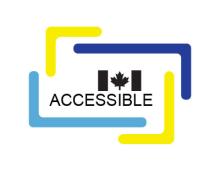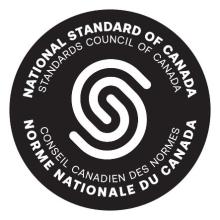CAN-ASC-1.1:2024 (REV-2025) – Employment
3. ASC legal notice
Information
Table of contents
Technical committee members
- Mahadeo Sukhai, Researcher, self-employed (Chairperson)
- Andrew Livingston, Chief Executive Officer, Dexterity Consulting (Vice Chairperson)
- Gary Malkowski, Consultant, self-employed
- Monique Beaudoin, Consultant (semi-retired)
- Norma McCormick, Founder and Principal, Corporate Health Works Incorporated
- Don Gallant, National Director, Ready Willing and Able, Inclusion Canada
- Emile Tompa, Senior Scientist, Population/Workforce Studies Program, Institute for Work & Health
- Mark Wafer, Chair, Board of directors, Canadian Hearing Services
- Wendy Lau, Chief Executive Officer, Leads Employment Services
- Christine Lund, Policy and Program Analyst, Indigenous Services Canada (ISC)
- Emmanuelle Lopez-Bastos, Human Rights, Equity and Diversity Coordinator, United Food and Commercial Workers Union
- Glen Hayes, Senior Human Resources Advisor, Treasury Board Secretariat
- Kelsey Baker, Compensation Consultant, Nova Scotia Education Common Services Bureau
- Orelie Di Mavindi, Manager, Opportunities Fund for Persons with Disabilities, Employment and Social Development Canada
- Seema Lamba, National Human Rights Officer, Public Service Alliance of Canada
- Pamela Lahey (member October 2020-April 2024)
- Jamie Burton, Chief Executive Officer, INNoVA
- Rachel Desjourdy, Accessibility Lead, CBC/Radio-Canada
- Steven Lewis, Manager, Senior Legal Counsel and Accessibility Advisor, Capital One Bank (Canada)
- Quinn Redekop, Senior Program Advisor, Accessibility Standards Canada
Please read this Legal Notice before using the Standard document.
3.1 Legal notice for standards
The Canadian Accessibility Standards Development Organization (operating as “Accessibility Standards Canada”) standards are developed through a consensus-based standards development process approved by the Standards Council of Canada. This process brings together volunteers representing varied viewpoints and interests to achieve consensus and develop standards.
3.2 Understanding this edition of the standard
Revisions may have been or may eventually be developed in relation to this edition of the Standard. It is the responsibility of the users of this document to verify if any revisions exist.
3.3 Disclaimer and exclusion of liability
This document was developed as a reference document for voluntary use. It is the responsibility of the users to verify if laws or regulations make the application of this standard mandatory or if trade regulations or market conditions stipulate its use, for example, in technical regulations, inspection plans originating from regulatory authorities, and certification programs.
Although the primary application of this Standard is stated in its scope, it remains the responsibility of the users of this Standard to judge its suitability for their particular purpose. It is also the responsibility of the users to consider limitations and restrictions specified in the purpose and/or scope of this Standard.
This document is provided without any representations, warranties, or conditions of any kind, expressed or implied, including without limitation, implied representations, warranties or conditions concerning this document’s fitness for a particular purpose or use, its merchantability, or its non-infringement of any third party’s intellectual property rights. Accessibility Standards Canada makes no representations or warranties in respect of the accuracy, completeness, or currency of any of the information published in this document. Accessibility Standards Canada makes no representations or warranties regarding this document’s compliance with any applicable statute, rule, regulation or combination thereof.
In no event shall Accessibility Standards Canada, its contractors, agents, employees, directors, or officers, or His Majesty the King in Right of Canada, his employees, contractors, agents, directors, or officers be liable for any direct, indirect, or incidental damages, injury, loss, costs, or expenses, however caused, including but not limited to special or consequential damages, lost revenue, business interruption, lost or damaged data, or any other commercial or economic loss, whether based in contract, tort (including negligence), or any other theory of liability, arising out of or resulting from access to or possession or use of this document, even if Accessibility Standards Canada or any of them have been advised of the possibility of such damages, injury, loss, costs, or expenses.
In publishing and making this document available, Accessibility Standards Canada is not undertaking to render professional or other services for or on behalf of any person or entity or to perform any duty owed by any person or entity to another person or entity. The information in this document is directed to those who have the appropriate degree of knowledge and experience to use and apply its contents, and Accessibility Standards Canada accepts no responsibility whatsoever arising in any way from any and all use of or reliance on the information contained in this document.
Accessibility Standards Canada publishes voluntary standards and related documents. Accessibility Standards Canada has no power, nor does it undertake, to enforce conformance with the contents of the standards or other documents published by Accessibility Standards Canada.
3.4 Intellectual property and ownership
As between Accessibility Standards Canada and users of this document (whether it be printed, electronic or alternate form), Accessibility Standards Canada is the owner, or the authorized licensee, of all copyright and moral rights contained herein. Additionally, Accessibility Standards Canada is the owner of its official mark. Without limitation, the unauthorized use, modification, copying, or disclosure of this document may violate laws that protect Accessibility Standards Canada and / or others’ intellectual property and may give rise to a right in Accessibility Standards Canada and / or others to seek legal redress for such use, modification, copying, or disclosure. To the extent permitted by licence or by law, Accessibility Standards Canada reserves all intellectual property and other rights in this document.
3.5 Patent rights
Some elements of this Standard may be the subject of patent rights or pending patent applications. Accessibility Standards Canada shall not be held responsible for identifying any or all such patent rights. Users of this Standard are expressly informed that determination of the existence and / or validity of any such patent rights is entirely their own responsibility.
3.6 Assignment of copyright
In this legal notice, a “comment” refers to all written or orally provided information, including all suggestions, that a user provides to Accessibility Standards Canada in relation to a standard and / or a draft standard. By providing a comment to Accessibility Standards Canada in relation to a standard and / or draft standard, the commenter grants to Accessibility Standards Canada and the Government of Canada a non-exclusive, royalty-free, perpetual, worldwide, and irrevocable licence to use, translate, reproduce, disclose, distribute, publish, modify, authorize to reproduce, communicate to the public by telecommunication, record, perform, or sublicense the comment, in whole or in part and in any form or medium, for revising the Standard and/or draft Standard, and/or for non-commercial purposes. By providing the comment, the commenter being the sole owner of the copyright or having the authority to license the copyright on behalf of their employer, confirms their ability to confer the licence and the commenter waives all associated moral rights, including, without limitation, all rights of attribution in respect of the comment. Where the provider of the comment is not the comment’s author, the provider confirms that a waiver of moral rights by the author has been made in favour of the provider or the comment’s copyright owner. At the time of providing a comment, the commenter must declare and provide a citation for any and all intellectual property within the comment that is owned by a third party.
3.7 Authorized uses of this document
This document, in all formats including alternate formats, is being provided by Accessibility Standards Canada for informational, educational, and non-commercial use only. The users of this document are authorized to do only the following:
- Load this document onto a computer for the sole purpose of reviewing it;
- Search and browse this document;
- Print this document if it is in electronic format; and
- Disseminate this document for informational, educational, and non-commercial purposes.
Users shall not and shall not permit others to:
- Alter this document in any way or remove this Legal Notice from the attached Standard;
- Sell this document without authorization from Accessibility Standards Canada;
- Use this document to mislead any users of a product, process or service addressed by this Standard; or
- Reproduce all of, or specific portions of the Standard within other publicly available standards documents or works, unless Accessibility Standards Canada grants, in writing, permission to do so and the following attribution is included by the user: “This material comes from [insert title of standards] and cannot be further reproduced without Accessibility Standards Canada’s authorization”.
If you do not agree with any of the terms and conditions contained in this Legal Notice, you must not load or use this document or make any copies of the contents hereof. Use of this document constitutes your acceptance of the terms and conditions of this Legal Notice.
National Standard of Canada
CAN/ASC–1.1:2024 (REV-2025)
Employment


Published in May 2025 by Accessibility Standards Canada
A departmental corporation of the federal government
320, Saint-Joseph Boulevard, Suite 246, Gatineau, QC, K1A 0H3
To access standards and related publications, visit accessible.canada.ca or call 1-833-854-7628.
Cette Norme Nationale du Canada est disponible en versions française et anglaise.
ICS code(s): 03.040, 03.060, 03.080, 03.100 and 03.220.
ISBN 978-0-660-74378-3
Catalogue number AS4-40/1-2024E-PDF
© His Majesty the King in Right of Canada,
as represented by the Minister responsible for the Accessible Canada Act (i.e. the Minister of Jobs and Families), 2025.
No part of this publication may be reproduced in any form without the prior permission of the publisher.